Marvel and DC have traditionally had a stronghold on celebrities when it comes to comic books and their characters. Their popularity can only be respected, not questioned. Today, however, we will be discussing one of the most underappreciated comic book characters, ‘Hellboy.’ Hellboy is a well-intentioned half-demon transported to Earth to destroy reality, but instead becomes the world’s finest paranormal detective. Hellboy is published by Dark Horse Comics and created by Mark Mignola.
Lovecraftian themes, pulp fiction, horror, and folklore drive the comic book plots and characters. ‘Ogdru Jahad’ is one such monster character from the comics. The Ogdru Jahad are the seven gods of chaos and serpentine creatures who have been imprisoned in a crystal prison for the sole purpose of destroying the planet.
These creatures were created using a combination of Christian mythology and Lovecraftian ideas, including Mignola’s first sketches. Later, with the help of Del Toro, the monster’s design took a turn away from its original serpentine form. So, without further ado, let us delve into the mythical and terrible ‘Ogdru Jahad’ character’s origins and details.
WHO IS OGDRU JAHAD?
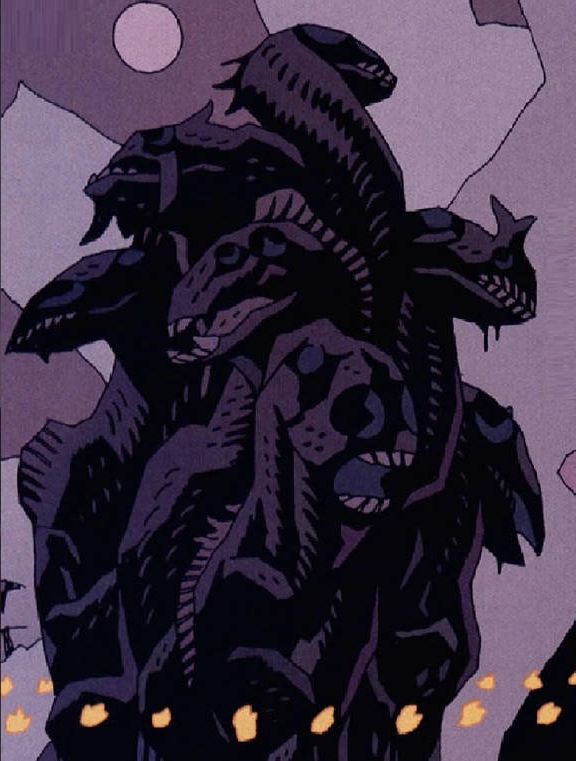
The Ogdru Jahad, alternatively known as the ‘Ogdru be Jurhad’, were gigantic monsters derived from H.P Lovecraft’s Cthulhu Mythos. In the Biblical sense, they are the seven-headed Dragon of Revelation and are prophesied to bring about the doom of the world. The Ogdru Jahad along with The Serpents, The Beasts, the Seven Who Are One, and the Seven Gods of Chaos, is the major adversaries of Mike Mignola’s “Hellboy” comic book series.
The Right Hand of Doom imprisoned them in their Golden Cocoons shortly after the genesis of Earth, but not before they bore 369 children known as the Ogdru Hem. At the beginning of time, God had formed an order of spirits. Many of the Greater Spirits were dispatched to the fledgling Earth to serve as Watchers. Anum, one of these spirits, fashioned the Ogdru Jahad from fire and dirt. The other spirits began to cast spells and wards around the Dragon, even re-infusing it with fire, but the entity remained dead.
However, when darkness fell, the Ogdru Jahad awakened and was imbued with purpose and function, giving birth to the Ogdru Hem, the Earth’s earliest lifeforms. The physical appearance of the Ogdru Jahad is similar to that of archaeopteryx, with some aquatic features. The several attempts of the comic’s antagonists to liberate the Ogdru Jahad make it clear that the liberation of the Ogdru Jahad is inextricably linked to the destruction of mankind.
It is unknown whether the fall of man causes or immediately follows the release. Ogdru Jahad’s intentions may be hard to explain in human words as an immortal and massively powerful being whose ultimate nature transcends understanding. Aside from the core notion of gaining liberation and subsequently destroying the Earth, there is considerable disagreement over what the Ogdru Jahad will do once free.
The aliens that keep an eye on the Ogdru Jahad’s cosmic prison appear to view Earth as a focal point required to keep the prison running. If the Ogdru Jahad are allowed to free themselves, they will destroy the Earth and ultimately the whole Universe.
Herman von Klempt thinks that after man is eliminated, the 369 Ogdru Hem will break free from their confinement, liberate the Ogdru Jahad, and burn the Earth to ashes. Similarly, Hellboy’s hand was seized and used to liberate the Ogdru Jahad, who subsequently burned the earth to cinders in Bog Roosh’s nightmares.
OGDRU HEM – THE 369 CHILDREN OF THE DEMONIC OGDRU JAHAD
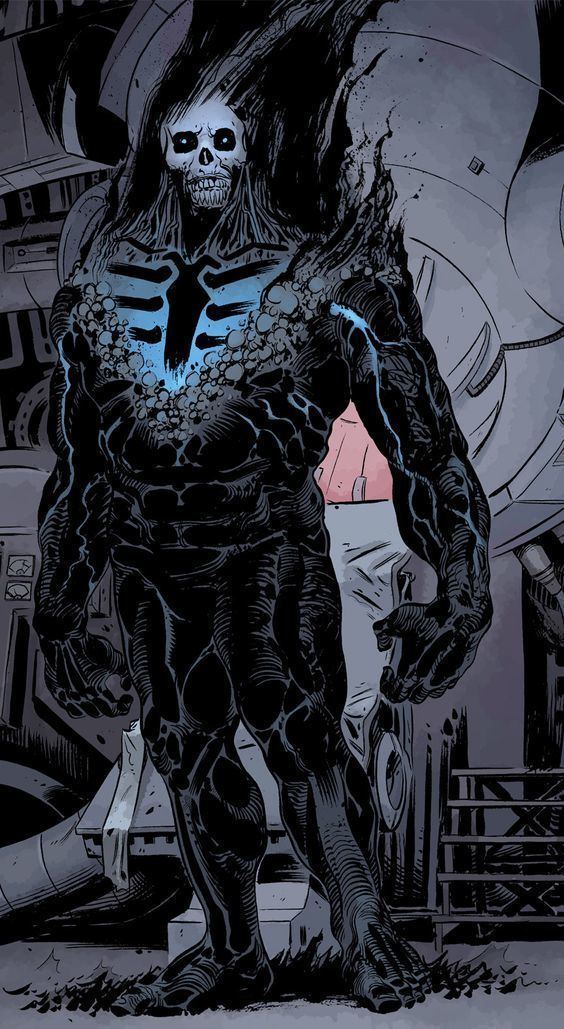
The grotesque 369 progeny of the evil Ogdru Jahad are known as the ‘Ogdru Hem’. Even though the Ogdru Hem is simply inferior replicas of their parents, they hold unfathomable power. The Watchers imprisoned all of the Ogdru Hem, but many are now re-emerging with the help of Grigori Rasputin and other Ogdru Jahad spies. Several of the Ogdru Hem have no bodies and dwell in the air, unseen.
Under investigation, the physical form of at least one Ogdru Hem has been determined to be a type of fungus. This body was fashioned from blood at some time in the distant past, leaving it uncertain whether the same is true for the initial bodies fashioned by the Ogdru Jahad. Every one of the Ogdru Hem may modify living organisms with their breath, with frogs being the most prominent example.
Cipactlhem
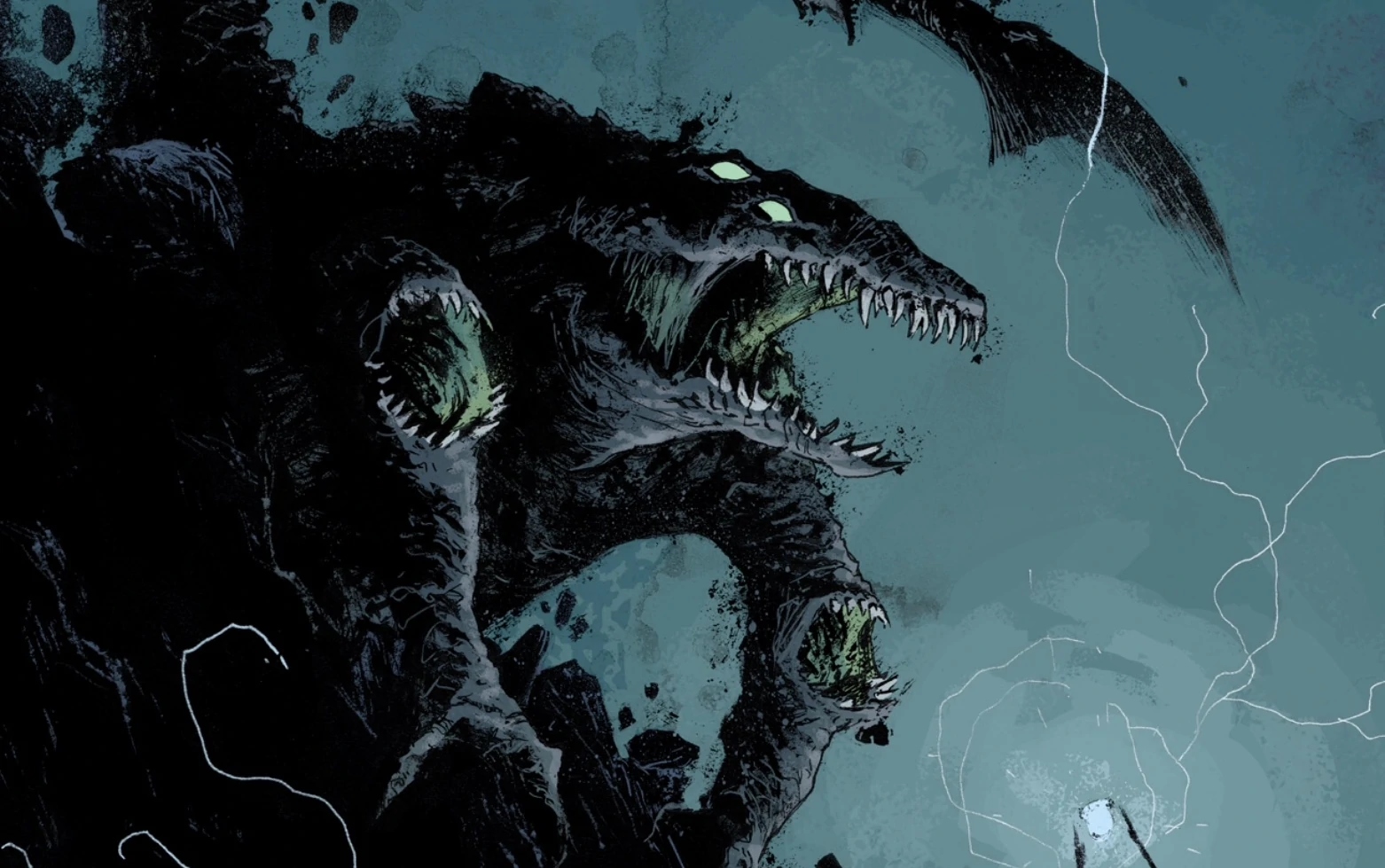
‘Cipactli’ was the first day of the Aztec divinatory count of 13 X 20 days, and Cipactonal, the “Sign of Cipactli,” was thought to be the first diviner. The crocodile represented the earth floating in primordial waters in Aztec cosmology. According to one Aztec legend, ‘Teocipactli’, or Divine Crocodile was the name of a flood survivor who recovered in a kayak and colonized the land. Crocodile Day is related to dynasty origins in the Mixtec Vienna Codex.
Cipactli was a prehistoric sea creature of undetermined gender who was part crocodile, part fish, and part toad or frog. Every joint on its body was ornamented with an additional mouth because it was always hungry.
Tezcatlipoca, the god, sacrificed afoot as bait to bring the monster closer. He and Quetzalcoatl formed the earth’s body. Cipactlhem was a deity worshipped by the Aztec but was originally an Ogdru Hem spirit. The monster had its first comic book appearance in “The Shape of Things to Come”.
The Conqueror Worm
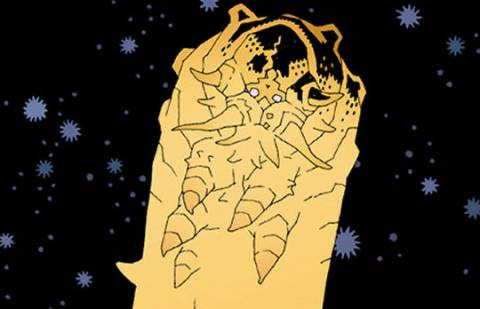
The Conqueror Worm was one of the 369 Ogdru Hem. The Conqueror Worm gets its name from Edgar Allan Poe’s poem of the same name. It is often used as the American title for Vincent Price’s British horror film “Witchfinder General”. In 1939, anxious to obtain a decisive advantage over the Allies in World War II, the Nazis established contact with malicious creatures in space, who claimed that if a dead corpse was transported into space for one of them to occupy, it would return to Earth with the capacity to destroy their foes.
The Nazis wrapped the slain Dr. Ernst Oeming’s body in a spacesuit and launched it onboard a spaceship from Hunte Castle in Austria, but the mission was interrupted by Lobster Johnson. Herman von Klempt infiltrated Hunte Castle and reignited the ancient equipment, sending the recall signal to return Dr. Oeming’s capsule back to Earth 61 years later.
The Conqueror Worm emerged as it landed. Hellboy, Roger, and the Lobster’s spirit vanquished the Worm by using a power cell provided to Hellboy by the extraterrestrial. The Conqueror Worm has skills comparable to those of Sadu-Hem, who arrived at Cavendish Hall and resurfaced during the Plague of Frogs.
Ghennu-Hem
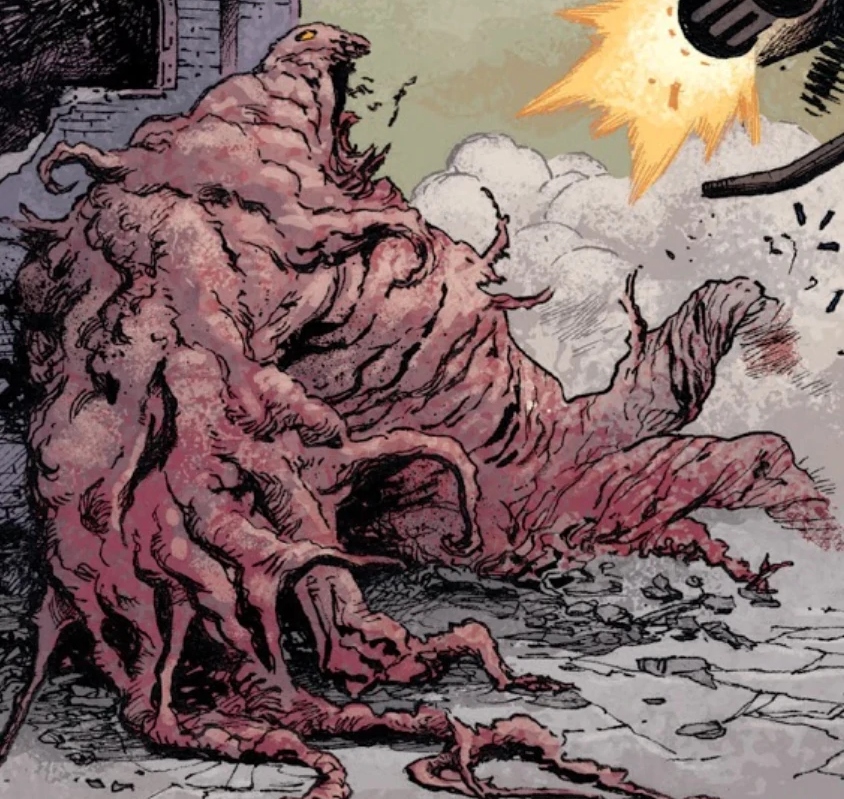
Ghennu-Hem was one of the Ogdru Jahad’s offspring. During the events of Hell on Earth, it came close to reviving itself. Abe Sapien traveled to Grayrock in San Juan County, Colorado, after leaving the B.P.R.D. during his second metamorphosis. Looking for a place to rest, Abe went to a nearby church and was cordially welcomed by the priest to spend the night there. Several survivors in the church were discovered to have been afflicted by mutations produced by the Ogdru-Hem, which the priest declared to be the presence of God.
When the priest and the enraged survivors turned aggressive towards one other, the priest explosively transformed into an enormous monstrosity in an instant. This monster proclaimed the name ‘Ghennu-Hem’, stating that the human spirit within him was not alone and that he was more than simply the priest.
Istra-Hem
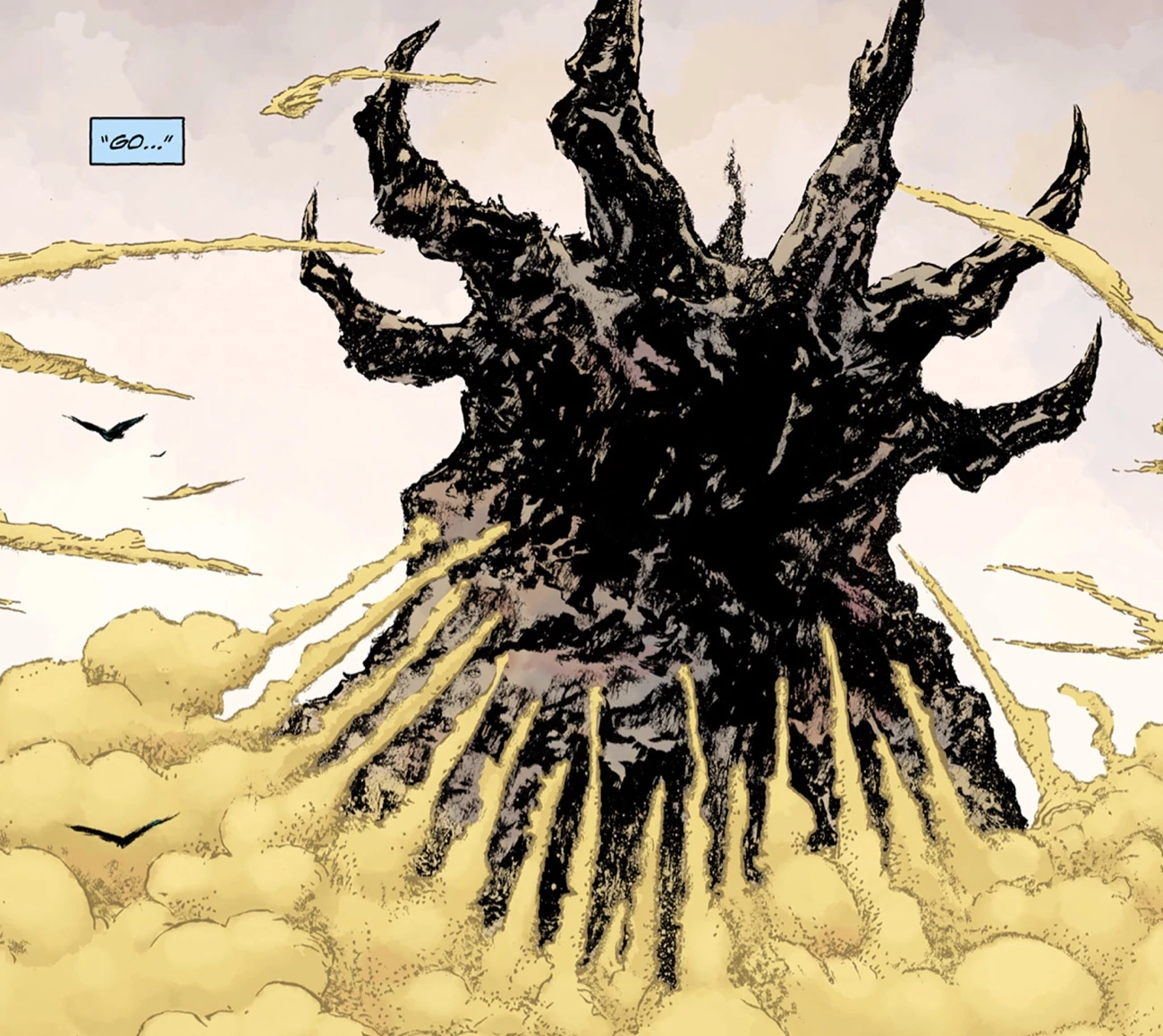
Istra-Hem is one of the imprisoned Ogdru Hem in the Mona-egg. Like Sadu-Hem and the Conqueror Worm, it also uses its breath to generate frog creatures.
Katha-Hem
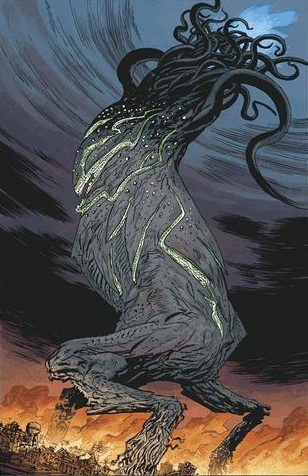
Serving the third Black Flame, The Katha-Hem was one of the 369 Ogdru Hem or Ogdru Jahad’s children. Being larger than even the seven Ogdru Jahads, it is the only known Ogdru Hem capable of altering inanimate objects with its breath. Katha-Hem was the fourth and perhaps the most fearsome of the Ogdru Hem to be unleashed on the planet. While Sadu-Hem was predicted to bring about the Plague of Frogs, the appearance of Katha-Hem signaled that the world was about to alter.
Mera-Hem
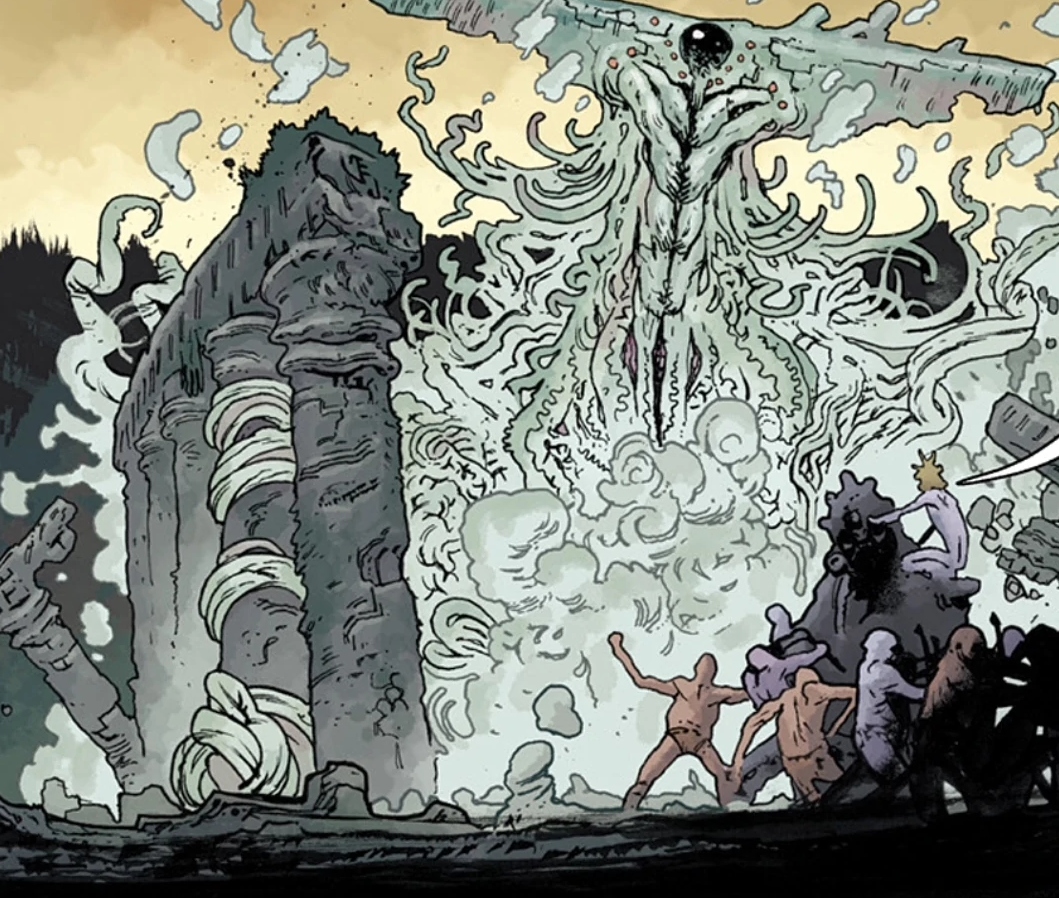
While chasing a Cold People clan, the ancient tribe commanded by Gall Dennar came upon Mera-Hem. The clan was led into a valley by the hunt, where they discovered an ancient decaying temple devoted to the Black Goddess.
Before a huge fight between the two sides, a leader among the Cold People insulted Gall Dennar and his tribe. Karr, a prehistoric scout, was hurt early into the combat and slipped bleeding into the temple’s ground. This blood, together with the severity and violence of the conflict, brought the soul of Mera-Hem to the temple, where he attacked and killed both the cavemen and the Cold People. Things appeared gloomy until Gall Dennar killed the Cold People’s leader, causing Mera-Hem to disperse into the air.
Mister Tod’s creature
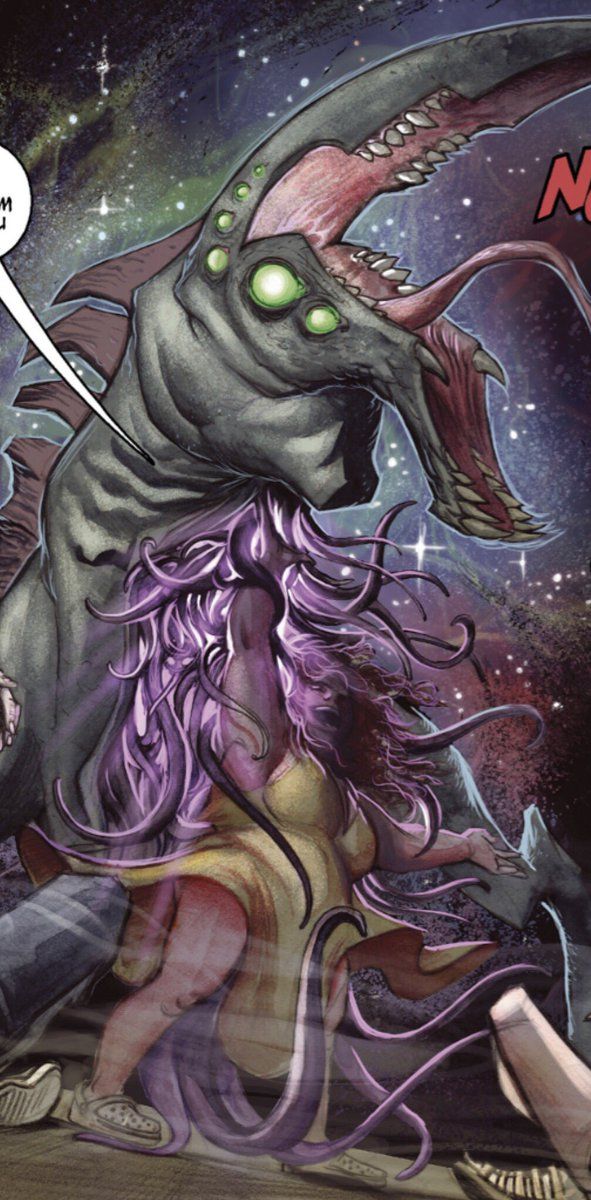
The appearance of Mr. Tod’s creature can be traced back to 1979, when Hellboy visited Portland, Oregon. Mr. Tod’s assistant, Mary Ann Glozek, requested assistance from the B.P.R.D. Hellboy had seen Mr. Tod, a corporeal medium, perform a few years ago, who was now under drugs to enter his trance state.
However, this time Mr. Tod made contact with something different altogether, in the shape of a tentacled entity that partially emerges from Mr. Tod’s ectoplasm. Hellboy burns Arbutus, an herb intended to ward off evil, but not before the beast captures Hellboy. The Creature and Hellboy are dragged back into Mr. Tod’s body. Mr. Tod’s corpse expands and crumbles, leaving Hellboy standing.
Sadu-Hem
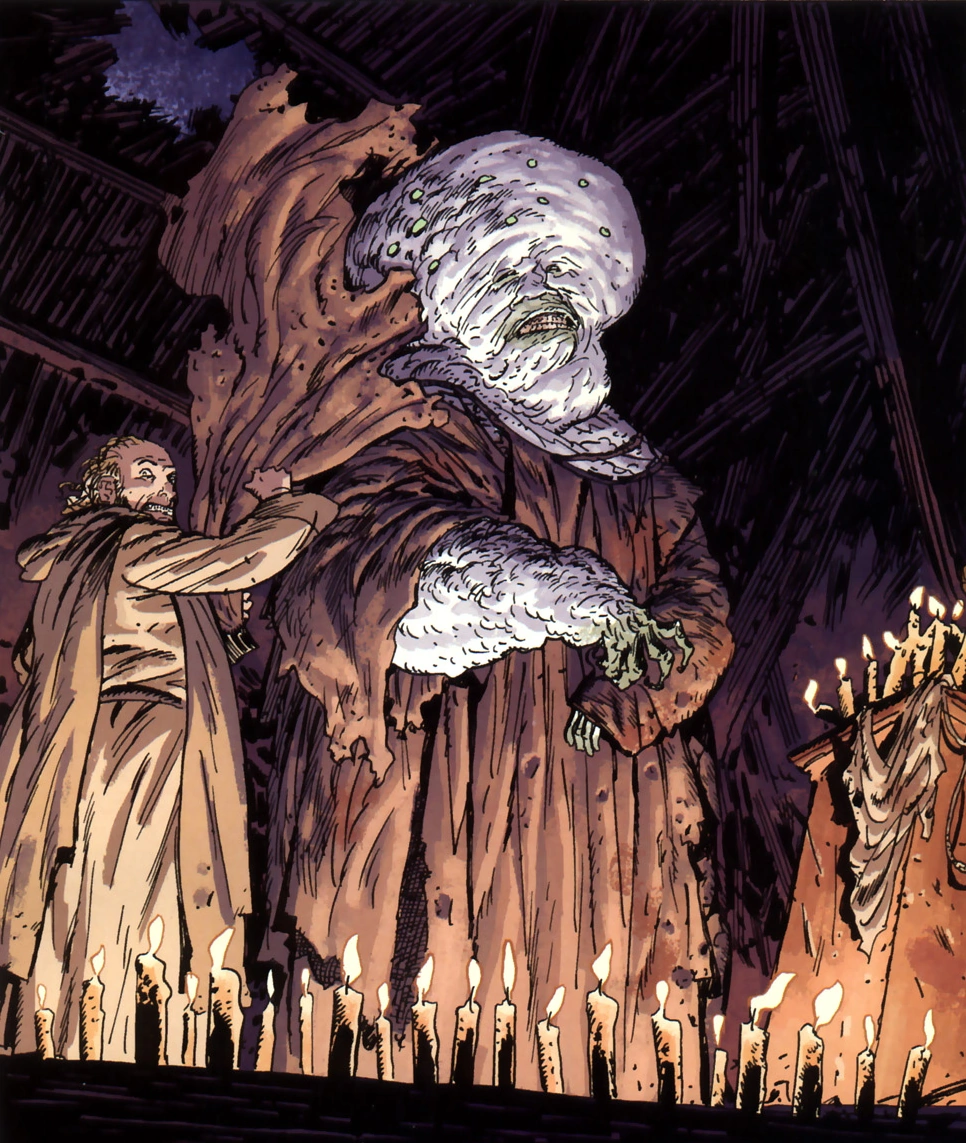
The Ogdru Jahad made Sadu-Hem. He was slain by the Watcher Angels and subsequently reincarnated at Gorinium following the Fall of Hyperborea. Sadu-Hem was found by Grigori Rasputin in the Gorinium temple at the top of the Arctic circle, imprisoned on Earth so that the Ogdru Jahad would “always have a footing in the land from which they were expelled.” Sadu-Hem physically looked like a hideous mess of tentacles and snapping claws, with a cluster of eyeballs and feelers acting as its head.
Sadu-Hem was supposed to be the link between Rasputin and the Ogdru Jahad but was demolished after Abe Sapien jabbed Rasputin to death and Liz Sherman set fire to the entire site. Even though Sadu-Hem was supposedly destroyed, a little bit of him was discovered in the Cavendish Hall ruins by the B.P.R.D. Director Thomas Manning had the specimen of fungus kept in a New Jersey facility until Sadu-Hem became strong enough to assimilate a human form and flee. Before being ritually sacrificed by Liz Sherman again, Sadu-Hem fled to Crab Point, Michigan, and turned the entire town into savage frog monsters.
Urgo-Hem
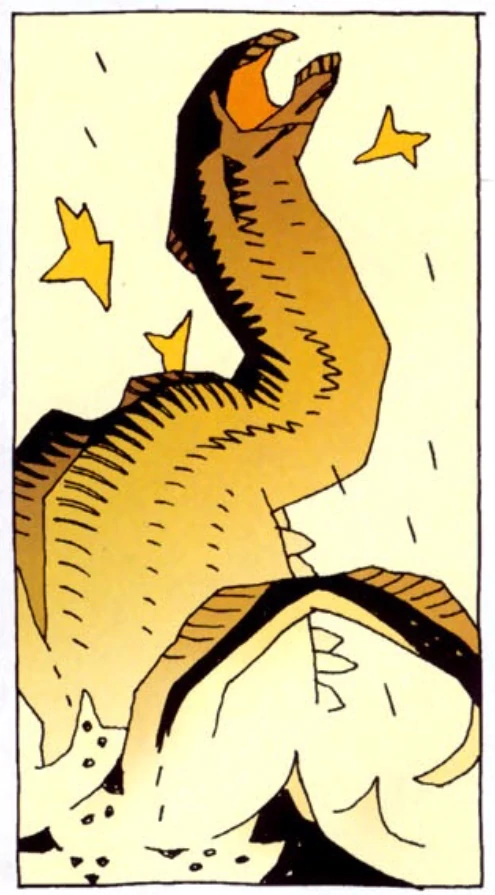
Urgo-Hem was one of the 369 Ogdru Hem. Urgo-Hem was set free thanks to the blood of a 16th-century Spanish priest. The priest had spent some time at Tenochtitlan before he perished and had studied about the Ogdru Hem’s history there. Urgo-Hem was unleashed by the priest’s blood when Hellboy came upon him. This kid of the Ogdru Jahad appeared to be an aquatic beast, with pointed crustacean legs bordering its pale underbelly. Urgo-Hem skewered itself on the mast of a neighboring shipwreck after a terrible struggle, and Hellboy fled.
Yotha-Hem

Yotha-Hem, one of the Ogdru Jahad’s offspring, is said to be the thing that tormented the survivors of an excursion to the earth’s hollow areas. Before the city’s demise, Hyperborean priests who had been committed to Hecate’s devotion summoned the Ogdru-Hem, along with an entity known as Yotha-Hem. This is most likely the same Ogdru-Hem creature that attacked Frankenstein’s Monster.
Zara-Hem
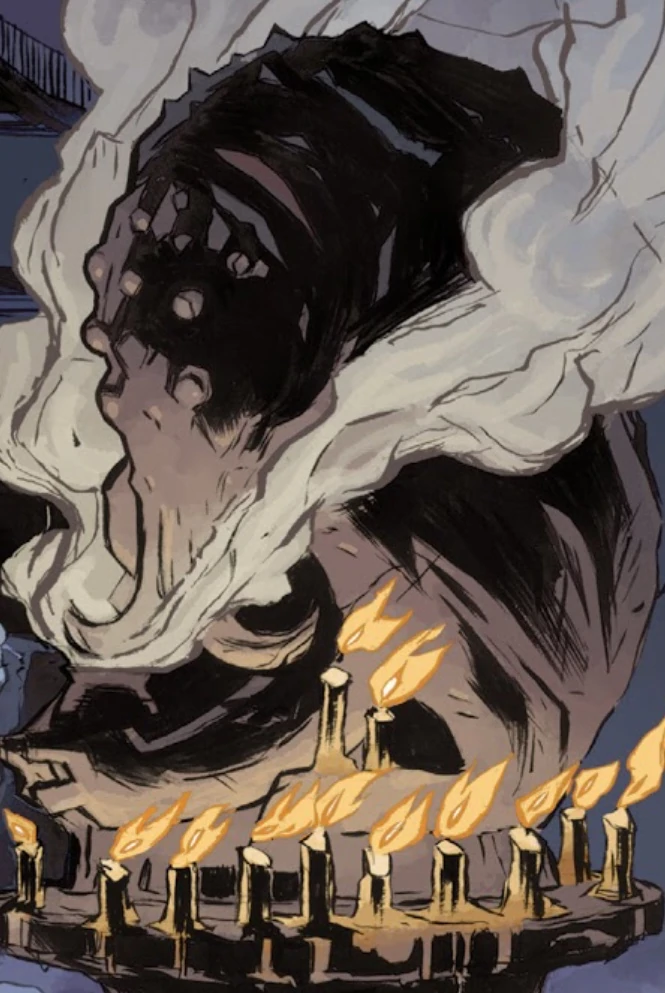
In the millennia before the Europeans arrived in North America, Zara-Hem was worshipped in Arizona. A tribe of archaic people sought to summon Zara-Hem by sacrificing a couple. The Visitor, who was headquartered on Earth at the time, utilized the Prism to drive Zara-Hem away, rendering its followers incapacitated. Prior to the events in Beware the Ape, an ape cultist stole a statue of Zara-Hem. In 1952, a Portuguese statue of Zara-Hem, which had been feeding on anguish in the citadel, collided with Herman von Klempt’s zombie. The undead morphed and enlarged, launching an attack from above on Von Klempt and Hellboy. A gas explosion destroyed the corpse, rendering Zara-Hem body-less once more.
Salton Sea Monster
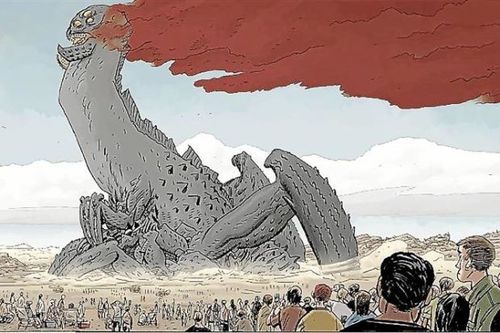
During the international upheaval sparked by Liz Sherman, this monster rose from the Salton Sea. It possesses a reptilian/crustacean body, a lengthy neck, and an arthropod-like head from which scarlet-colored vapors are emitted, causing those who inhale them to change into grey, arthropod-like creatures. When the Black Flame comes back to earth, the Monster proceeds to wander away to an unknown destination, leaving some eggs behind. One of these eggs hatches and dies in the Salton Sea, while another is destroyed by Fenix in order to destabilize a cult that had arisen.
Quetzalcoatl
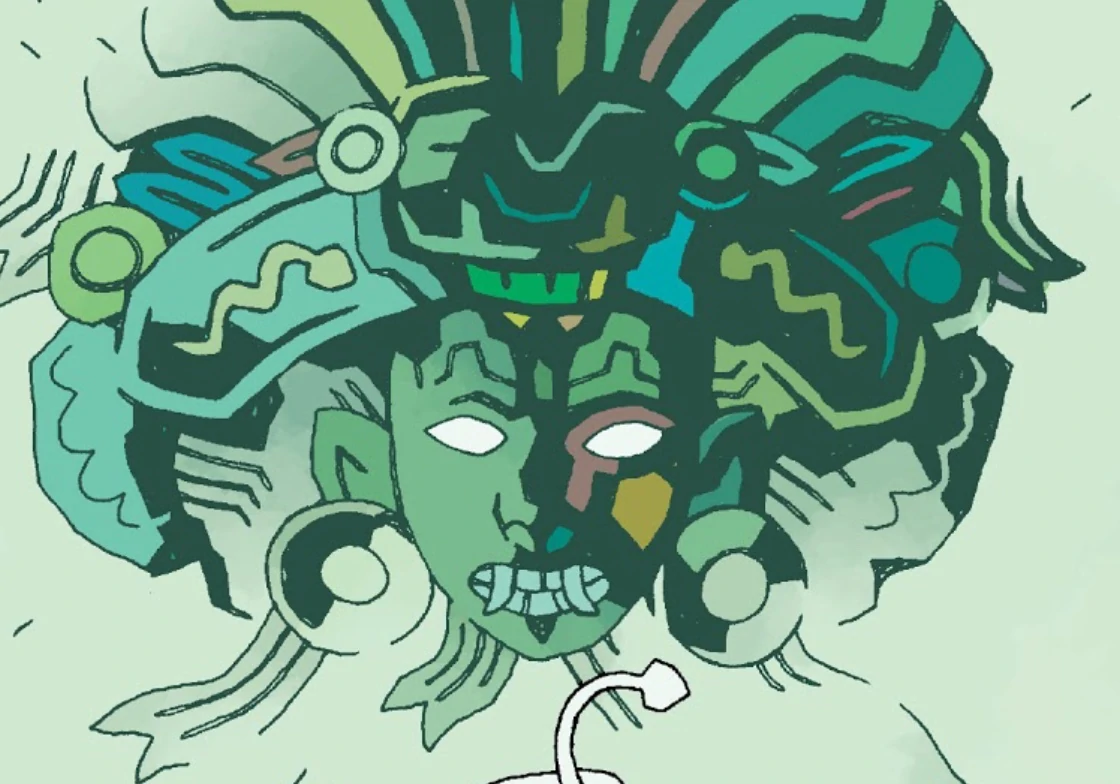
Quetzalcoatl, often known as the “Feathered Serpent,” was a significant god to the ancient Mesoamericans. With the advent of the Toltec civilization around 900 A.D., Quetzalcoatl worship expanded across the region, reaching down to the Yucatan peninsula, where it was adopted by the Maya. To trace the history of Quetzalcoatl worship, one must travel back to the birth of Mesoamerican civilization.
The ancient Olmec civilization lasted roughly from 1200 to 400 B.C. and had a huge influence on all following civilizations. La Venta Monument 19, well-known Olmec stonework, depicts a man seated in front of a feathered snake. Although this demonstrates that the notion of a heavenly feathered serpent has existed for a long time, most historians conclude that the Quetzalcoatl religion did not emerge until the late Classic era, hundreds of years later.
Quetzalcoatl was a significant deity in the Aztec pantheon. The gods frequently destroyed and rebuilt the world in their mythology. Each age of the planet was granted a new sun, and the world was on its Fifth Sun after being destroyed four times before. Quetzalcoatl’s feuds with his brother Tezcatlipoca were occasionally responsible for the world’s devastation.
Vucub Caquix
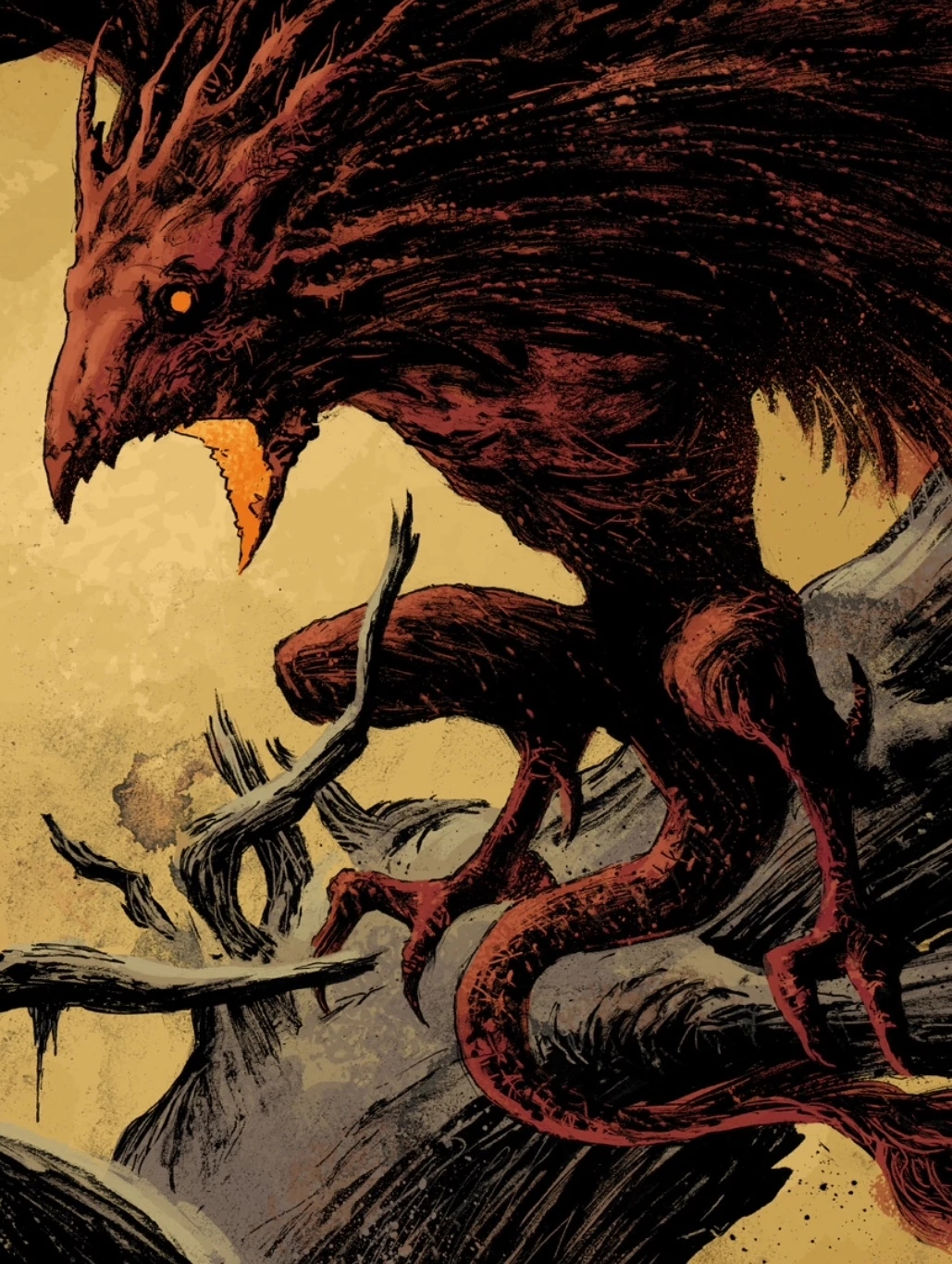
Vucub-Caquix, a bird demon, was destroyed by the Hero Twins as per an 18th-century text named Popol Vuh. The story of the demon’s destruction was known as early as the Late Preclassic Period, much before the year 200 AD. He also was the father of Zipacna, a demon deity from the underworld, and Cabrakan, the Earthquake God. Vucub-Caquix is portrayed as a mighty bird who masquerades as the sun and moon of the twilight world between the former and current creations. His name, according to contemporary Kiche, relates to the seven stars of the Big Dipper asterism.
Aside from the above-mentioned depictions on stone, the identification of Classic Mayan bird-shooting images on pottery with the shooting of Vucub-Caquix poses difficulties. For one thing, the bird in question is usually Itzamna’s avian change, and the notion of a universally respected creator deity appears to be at odds with the demonic character of Vucub-Caquix. Second, the shooting of the Principal Bird Deity has components that are not seen in the Quichean story.
OGDRU JAHAD APPEARANCES
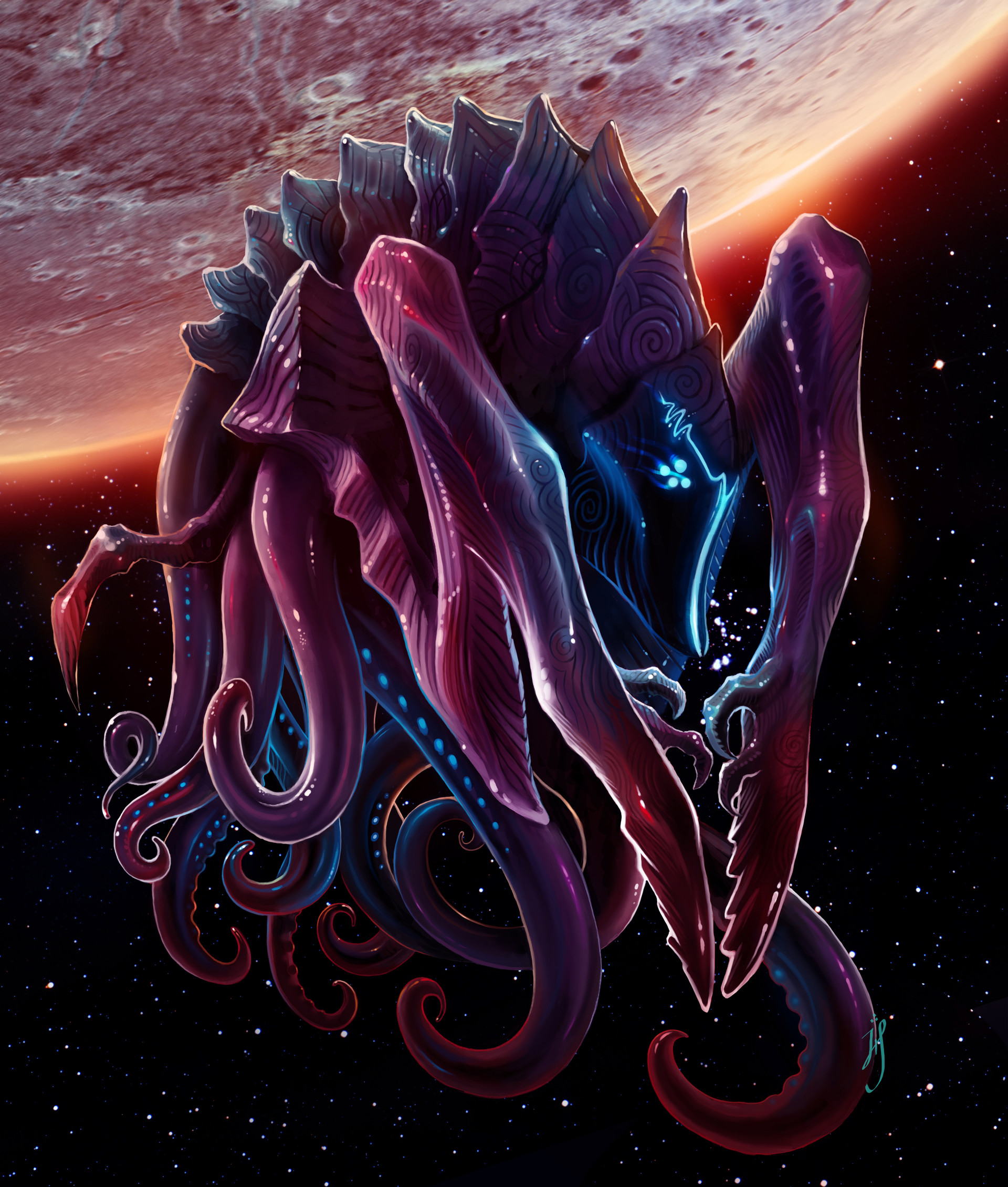
The Ogdru Jahad are serpentine/crustacean beings that previously inhabited and reigned over Earth, and are heavily influenced by the Great Old Ones of H. P. Lovecraft’s Cthulhu Mythos. They are pitiless, chaotic, hell-bent on destruction and domination, and frequently so horrifying in appearance that the sheer sight of one of them may cause insanity.
Their appearances are seen in the movie “Hellboy” and the animated series, “Hellboy: Sword of Storms”. In the film “Hellboy”, Ogdru Jahad serves as the film’s overarching antagonist, albeit he is only addressed a few times by name. They look to be faintly cephalopod-like, mirroring their Lovecraftian inspiration more.
They are present somewhere in space, imprisoned in their crystal shells. Rasputin, Kroen, and Haupstein were successful in convincing Hellboy to use his Right Hand of Doom to begin the End Times by holding Liz Sherman. Agent John Myers was still able to bring Hellboy back to his senses, and he chose to call it a day before breaking the last lock. The Seven Gods of Chaos were confined once again, but one of their children, Behemoth, escaped to infiltrate the earth, only to be killed by Hellboy.
Ogdru Jahad appeared as the brothers of Thunder and Lightning in the animated “Hellboy: Sword of Storms”. Despite not being named, they were referred to as “Dragons”. “Hellboy: Sword of Storms” is the first instalment of the Hellboy Animated series, which is based on Mike Mignola’s iconic comic book series “Hellboy” and the live-action film of the same name. While reading the scroll in modern-day Japan, Professor Sakai gets possessed by the spirits of Thunder and Lightning.
Simultaneously, Abe Sapien and Liz Sherman are sent to the locations of troubling earthquakes, where they learn that Thunder and Lightning are calling their brethren, the Dragons. They encounter the same kitsune who directed Hellboy and are given the task of stopping the dragons. One of the dragons attacks them, but Liz uses her pyrokinetic skills to keep it at bay.
